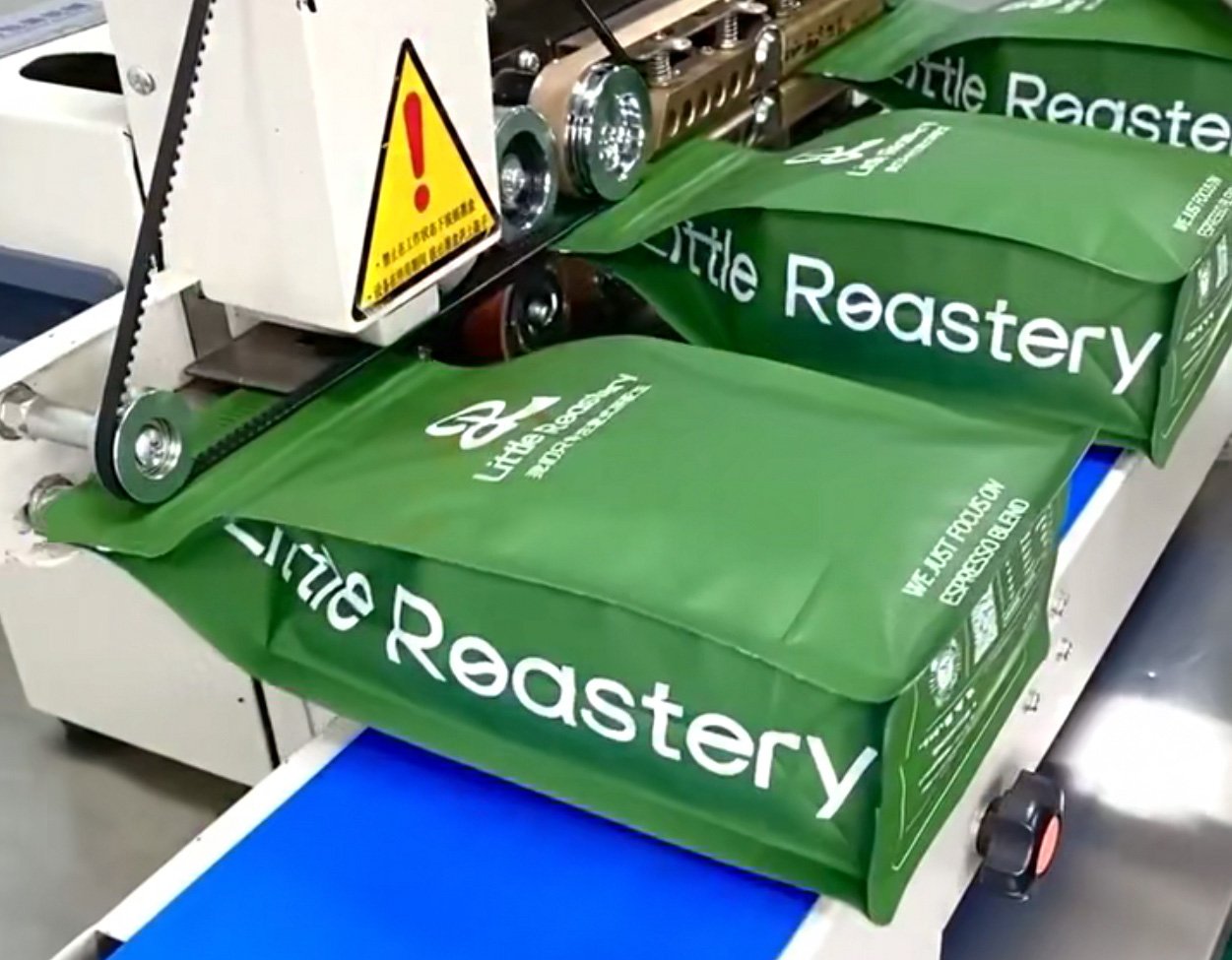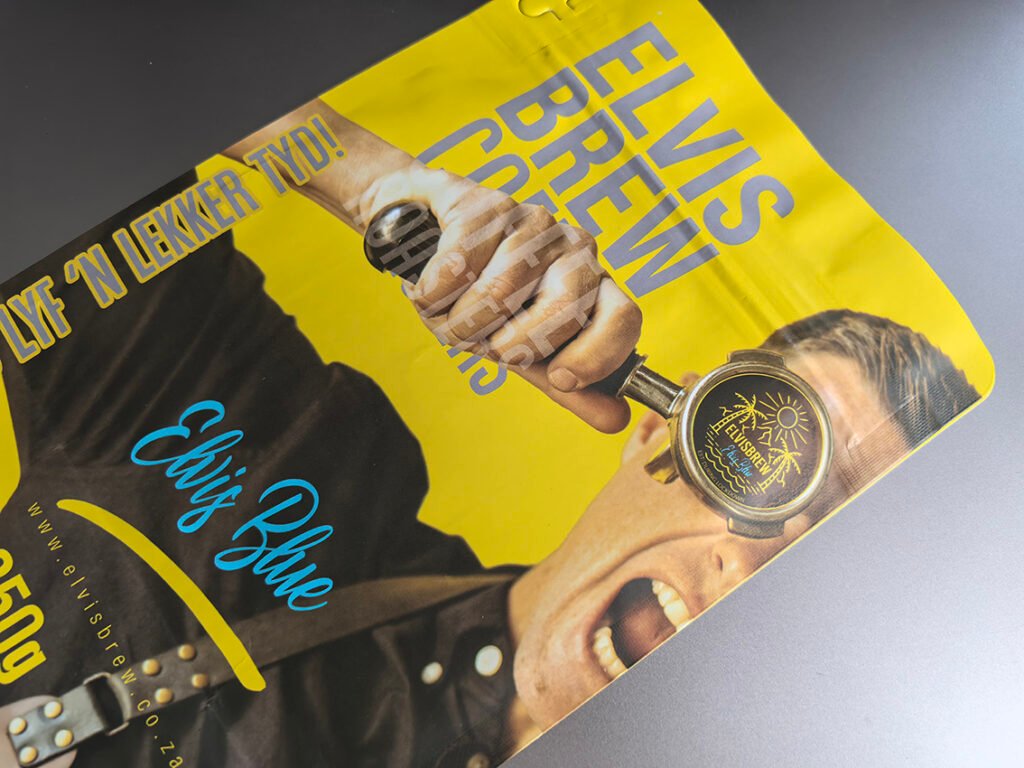
Coffee Bags: Why Heat Sealing Matters
In the world of specialty coffee, sealing isn’t just a technical step—heat sealing is a important control point. While consumers often focus on resealable zippers or tin ties, what truly protects a coffee’s freshness is the factory heat seal: the one-time, tamper-evident closure applied right after filling, degassing, and date coding.
This initial heat seal ensures that nitrogen stays in, oxygen stays out, and volatile aroma compounds remain protected. Without it, degassing valves can’t function properly, and even the best roast risks premature staling. Bags that puff during transit or lose their scent before arrival often point to poor sealing.
A strong factory seal also supports logistics strength. Whether palletized, compressed, or shipped internationally, sealed bags must withstand pressure changes and handling stress. A failed seal can result in burst packaging, damaged product, and reputational harm.
For coffee roasters relying on nitrogen flushing or degassed packaging, the factory seal acts as the final lock on freshness. It’s not meant to be reused—it’s meant to preserve. And it tells retailers and consumers alike: this bag was packed with care.
What Is a Coffee Bag Seal?
The term “coffee bag seal” refers to the hermetic closure formed at the top of the bag after filling. It’s the final step before the bag is packed and shipped. Unlike resealable features (zippers or tin ties), this seal is intended to be permanent until manually broken by the consumer. Its primary objectives:
- Lock out moisture and oxygen
- Prevent aroma loss
- Keep modified atmosphere (e.g., nitrogen flush)
- Ensure structural strength during transit
This seal is often 5 to 10mm below the true edge of the bag, using heat, ultrasonic vibration, or adhesive. The quality of this seal plays a direct role in the shelf life and customer perception of the product.
Moreover, the seal contributes to retail aesthetics. Misaligned or sloppy seals can detract from premium branding, while precise, strong seals reinforce perceptions of quality and care. This is particularly relevant in third-wave coffee, where packaging isn’t just function—it reflects values.
For private label coffee brands or exporters, the factory seal must meet both food safety standards and logistical demands. Whether shipping from China to Australia or Colombia to Canada, the seal is the coffee’s first and last line of defense.
In markets like Japan or Scandinavia, where aesthetic perfection is a cultural expectation, even minor sealing misalignments can lead to consumer complaints or distributor rejection. Many roasters now treat seal precision as part of their brand image, integrating it into their quality control checklist along with roast profiling and cupping.
Heat Sealing: The Industry Standard
Heat sealing is the most commonly used method for sealing coffee bags. It involves applying heat and pressure to the inner laminate of the bag to create a secure bond. Proper calibration of temperature, dwell time, and pressure ensures a reliable heat seal that can withstand transportation stress and keep product quality.
Key variables in heat sealing:
- Temperature: 160°C to 200°C
- Dwell Time: 0.5 to 2 seconds
- Pressure: Must be calibrated to material type
- Cooling: Solidifies the bond, prevents warping
Common seal types:
- Straight bar seals (smooth and clean)
- Crimp seals (serrated, textured)
- Dot seals (used in high-speed production lines)
Heat sealing works well with most materials used in modern coffee bags, including:
- Aluminum foil laminates
- Kraft-paper bags with plastic linings
- PLA-based compostables
- Recyclable mono-materials
For production, heat sealing scales efficiently. It integrates with both VFFS and HFFS systems, supporting everything from small batch runs to full automation.
From a sustainability perspective, heat sealing continues to evolve. New films require lower sealing temperatures and shorter dwell times, reducing energy consumption and improving eco-compatibility.
For roasters producing under 500 bags per day, impulse sealers may still suffice. However, as volumes scale and consistency becomes critical—especially for e-commerce—transitioning to continuous band sealers or even inline sealing in automated VFFS machines is advisable. The key is pairing machine type with material behavior and QA capacity.
Ultrasonic vs. Heat Sealing
Ultrasonic sealing uses high-frequency mechanical vibration to generate heat between bag layers, bonding them without external heating elements. It’s precise, efficient, and ideal for sensitive substrates.
Benefits:
- No external heat (avoids thermal damage)
- Minimal seal contamination
- High consistency under cleanroom conditions
Challenges:
- High initial equipment cost
- Requires precision calibration
- Not suitable for all bag styles or scales
Ultrasonic sealing is common in compostable packaging formats, especially where thermal stability is a concern. Brands prioritizing clean energy and sustainable innovation often invest in this method.
Cold Sealing: Fast and Fragile
Cold sealing uses pressure-sensitive adhesives pre-applied to the sealing area. No heat is involved—just pressure. It’s fast and widely used for temperature-sensitive goods like chocolate.
Limitations in coffee packaging:
- Weak barrier properties
- Can’t handle internal pressure from degassing
- Prone to accidental opening
- Not compatible with many eco-friendly films
Unless coffee is for immediate consumption or giveaways, cold sealing is rarely suitable. It lacks the structural reliability needed for transit and long shelf life.
Seal Failure from Poor Heat Sealing
In 2022, a medium-sized roaster in Europe launched a line of nitrogen-flushed single-origin coffees using compostable packaging. Within weeks, distributors began reporting bloated, ruptured bags.
The cause? Inconsistent heat sealing due to outdated sealing bars not calibrated to the PLA-based laminate. Despite investing in sustainable packaging, the lack of investment in heat sealing equipment and QA led to product loss, returns, and retailer distrust.
This highlights a key industry lesson: the seal must match the material. Upgrading to greener packaging without upgrading the sealing process is a high-risk move.
Conversely, a leading North American roaster uses automated VFFS machines with inline seal testing. They publish their seal strength data as part of their QA promise. This transparency has become part of their brand—consumers associate their product with both flavor and functional reliability.
Another trend among top-tier roasters is the adoption of seal strength metrics as part of their internal KPI dashboards. By testing seal tensile strength regularly and correlating it with freshness retention scores, they treat sealing as both a technical and sensory benchmark. This kind of data-driven packaging discipline is becoming a hallmark of export-ready brands.
Sealing from the Consumer’s Perspective
To the average consumer, a coffee bag’s seal may go unnoticed—until it fails.
Weak seals lead to:
Stale coffee before the bag is even opened
Unboxing disappointment if bags arrive misshapen
Distrust in brand quality, even if the coffee itself is good
In online reviews, customers rarely mention seal quality—unless it’s poor. Broken seals, leaking gas, or lack of pressure buildup are often flagged as signs of careless packaging or mishandling.
On the flip side, well-sealed bags that retain pressure are seen as proof of freshness. For subscription services or retail shelf brands, this small detail can shape customer loyalty and repurchase decisions.
How Heat Sealing Has Evolved
Coffee bag sealing has come a long way. In the 1990s, most commercial roasters relied on manual impulse sealers. These created inconsistent bonds, particularly on multi-layer laminates.
The 2000s saw the rise of automated band sealers, improving consistency. By the 2010s, nitrogen flushing became more common, placing greater demands on sealing strength.
Today, laser-guided heat sealing systems, integrated leak detection, and smart sealing controls are redefining packaging standards. These technologies auto-adjust sealing parameters in real time, making heat sealing more consistent, energy-efficient, and compatible with newer films.
This progression reflects the broader transformation of coffee from a commodity to a craft product. Packaging technology—especially sealing—has kept pace.
Looking ahead, AI-assisted sealing systems are emerging, capable of learning from failed seals and predicting settings before material changeovers. For roasters pursuing Industry 4.0 practices, sealing is now part of a connected packaging ecosystem—not a standalone step.
Sealing and Brand Value
In premium coffee, presentation is part of the product. And the seal is where form meets function.
Sloppy seals, wrinkled edges, or uncentered seams signal inconsistency. They erode confidence in the care behind the product. For direct-to-consumer roasters, the seal is often the first tactile interaction a customer has with the brand.
In contrast, crisp, uniform seals:
- Reinforce a sense of precision
- Convey product strength
- Subtly suggest higher value
Especially in retail settings, where shelf competition is visual, sealing quality helps command attention—and price.
Why Sealing Quality Matters
A weak or incomplete seal compromises more than aesthetics. It can result in:
- Nitrogen leakage or oxygen ingress
- Moisture absorption leading to mold or flavor fade
- Bag rupture during air transit
- Consumer dissatisfaction due to stale coffee or poor presentation
To ensure sealing quality, roasters implement:
- Visual inspection (uniformity, cleanliness)
- Tensile strength testing
- Dye penetration or vacuum leak tests
- Transport simulation (especially for exports)
In regulated markets, seal quality also intersects with food safety requirements. Weak seals may lead to recall risks, especially for certified organic or allergen-sensitive products.
Heat Sealing for Sustainable Packaging
As more roasters adopt eco-friendly packaging, sealing becomes a crucial technical challenge.
Material types and sealing notes:
- PE-based recyclable films: Easy to seal but deform if overheated
- PLA-based compostables: Require lower sealing temperatures
- Mono-material bags: Consistent sealing but need optimized dwell time
Some early bioplastics showed inconsistent melt behavior, which caused sealing failures. Newer generation films are more stable—but only when paired with precise equipment and trained operators.
In our work with roasters transitioning to certified compostable films, we’ve seen that 80% of seal failures stem from process mismatch—not from the film itself. This underscores the need to test materials under actual production humidity and pressure conditions. Sealing labs, pilot lines, or third-party QA partners can make or break a successful sustainable launch.
Sustainability goals must be matched by practical functionality. A recyclable bag with a weak seal is still a failed packaging.
Working with packaging partners who understand material behavior at the sealing stage is essential. This includes testing across:
- Ambient humidity and temperature
- Air transit pressure changes
- Real-world handling by distributors and retailers
Freshness Starts with Heat Sealing
While zippers and tin ties enhance user experience, freshness begins with the initial seal. For coffee roasters and brands, sealing is not just a technical procedure—it’s a commitment to quality.
A clean, strong, and consistent seal:
- Protects freshness
- Enhances logistics reliability
- Supports sustainability
- Elevates customer perception
In a competitive global market, mastering sealing is no longer optional. It’s part of brand identity, QA protocols, and customer retention. Because in specialty coffee, freshness doesn’t start when the bag is opened—it starts when the bag is sealed.
Yamipak Coffee can help you determine the best sealing solution for your coffee bags based on your actual production needs. We offer different models of heat sealers and sealing solutions to protect your specialty coffee from external factors and extend its shelf life.
Share This Story, Choose Your Platform!

Chris Li
Chris Li is the Marketing Director at YamiPak coffee, with over 10 years of experience in packaging and printing. Passionate about sustainable solutions and innovative design, Chris helps brands create impactful packaging that leaves a lasting impression.

